2.2 - Internationalisation and competition
Since the early 1990s internationalisation through foreign direct investment (FDI) and other forms of non-commercial internationalisation has had such an impact on firms in the Veneto that it is now one of the defining features of the region's development plan. Alongside direct investments aimed at strengthening global market penetration by facilitating the location and establishment of firms in recipient markets through greenfield investments and/or total or partial acquisition of foreign firms, the Veneto also fosters the relocation of production, by offshoring certain phases of the manufacturing process to countries with low labour costs, with the aim of making products more competitive. At the same time there has also been an increase in the number of foreign-invested enterprises in the Veneto in recent years. This is why this year's Statistical Report has introduced a new section dedicated to internationalisation through foreign direct investment.
After the extraordinary growth of the early '90s and the difficulties at the beginning of this millennium, which led to a significant decrease in world FDI flows, from 1,400 billion dollars in 2000 to 630 in 2003, internationalisation of production on a world scale has picked up well in recent years. According to UNCTAD (Note 1), in 2005 FDI reached 919 billion, replicating the success of 2004 (+27%) with a 29% increase on the previous year. Preliminary estimates for 2006 indicate further growth of 34%, coming close to1,200 billion dollars, not far from the record threshold. In the long term, FDI growth rates have remained well above Gross World Product and exports. This has allowed a "new economic landscape" to emerge, with a reduction in the share of industrialised countries as destinations for investments (from 80% in 1980 to less than 60% in recent years) and a spectacular increase in the share going to developing and newly industrialised countries (from 20% to 40%).
With the advance of globalisation countries with the longest history of industrialisation have, for the moment, maintained control of the main gateways of economic activity, while the locus of innovation in manufacturing is, at least in part, moving to new parts of the world. Another important phenomenon is the increasing relocation of highly skilled, knowledge intensive activities in more applied fields of R&D, involving other strategic assets for development, as in the broad sector of services.
FDI includes different forms of investment, such as mergers and acquisitions (M&As), expansion of already existing activities and greenfield investments, with equally diverse effects on the worldwide relocation of economic activity. M&As bring about a change in ownership of international production, but they do not modify territorial distribution. New foreign investments (expansions and greenfield investments), however, do modify this aspect, as do domestic investments within each country. Therefore an analysis which is limited to projects that add new assets to what already exists seems to be most appropriate way of describing the locations and pathways which are forming the new economic landscape (Note 2).
As regards outflows, Italy's contribution to the generation of new projects in the world, both greenfield investments and expansion of existing activities, is modest in comparison with the most industrialised countries (Note 3). The model of Italian firms' growth abroad mainly involves offshoring to nearby countries of Central and Eastern Europe and an effort to enter the markets of developed and rich countries which can appreciate the quality and design of products 'made in Italy'. However, this model is too weak to guarantee the flow of investments to those parts of the world which are currently the target of large-scale industrial projects and international investors. Recently Italian firms have initiated more projects in Asia than in the past. However, the extent of this remains modest if compared on an international level. Italy is also experiencing difficulties in international integration as regards inflows. Italy's profile is relatively weak compared with European standards, although Europe is a continent which is itself losing popularity as a destination for new investment flows. Italy is not seen as a particularly attractive destination for greenfield projects, particularly in comparison to other European countries with both traditional and emerging markets (above all Spain).
Italy's problems integrating into the new economic landscape deserve our attention because they reflect both the firms' ability to take part in the worldwide restructuring of the value chain and Italy's attractiveness as a destination for new economic projects. The need to play an active role in these new processes is heightened by the fact that not only are they profoundly altering the geographical distribution of activities, but they are leading to the fragmentation and diffusion of underlying knowledge and its possible relocation. A worldwide network is developing in the background which is regulating capitalist development. What counts here is excellence and leadership - without these there is the risk of marginalisation and demotion to the outskirts of the world. Marginalisation seems all the more serious if one considers the extraordinary growth of the world economy in recent years. The risk is that the country wears itself out in an increasingly stagnant environment and that the firms' poor attractiveness to inflows and their failure to open up abroad become a vicious circle.
Information retrieved from the Reprint database (Note 4) regards of internationalisation through equity investment, including majority and minority shareholding of subsidiaries, branch offices, affiliates, joint ventures, cross-shareholdings to support strategic alliances. The database is thus not limited to foreign direct investment flows since, as is well known, only some of these international operations, however important they may be, are financed through movements recorded in balances of payments. This is because it is possible to obtain supplementary financial resources on the markets of destination.
The database covers the whole system of industrial enterprises and the combination of services which support their activity (Note 5).
In short, the report highlights how the first few years of this millennium marked a decline in outgoing investments, after the dynamic growth in productivity abroad of our SMEs and a selection of medium-sized industrial groups in the previous decade. However in the last two years (2005-2006) the number of projects has increased, in the manufacturing and trade sectors at least, with manufacturing mainly directed towards Central and Eastern Europe and Asia. Italy's SMEs have started to actively take up activity abroad again, but this is inevitably limited to small-scale investments. Moreover, an internationalisation model based on small enterprises is intrinsically weak. Although these small companies often boast greater competence and sharing of knowledge and experience than the same sized companies in other countries, thanks to territorial agglomeration, they cannot fail to suffer from the constraints that small companies all over the world share in terms of financial and managerial resources and the ability to access and accumulate "firsthand" experience and information of international markets.
As regards inflows, levels of foreign participation in Italy have remained modest, both in greenfield investments and acquisitions and partnerships. This is aggravated by Italy's poor attractiveness in the sectors of high technology and advanced services. The strong recovery of FDI on a world scale, which began in 2004 after the drop in the first few years of the millennium, has not affected this. The importance of a strong presence of multinational enterprises (MNEs) for internationalisation in all advanced areas can only be confirmed. Their contribution is both direct, in terms of employment, innovation, development of managerial skills and growth of the enterprise system; and indirect, in terms of the externality, spillovers and competitive stimuli which they generate. This is particularly true in the manufacturing and service sectors, which are more closely involved in international integration. One externality related to this is the positive influence the presence of MNEs has on the projection of the host country's firms abroad, since they act as bridges to the foreign markets. In other words, a virtuous spiral of globalisation is set up whereby a country's openness to foreign investment facilitates the projection of its own companies abroad, through business relations and mobility of resources. It is also worth emphasising the circular relationship between competitiveness and internationalisation: On the one hand a competitive territory attracts MNEs, but on the other, as several studies have shown, the performance of firms acquired by MNEs in terms of productivity and increased employment is, ceteris paribus, often significantly better than that of local companies due to the greater ability of MNEs to make the most of their assets and introduce them into important international circuits. The canonical view, according to which greenfield investment in production is the best way to bring value to the host country is thus obsolete. Adopting an open attitude to new sectors of activity and cross-border M&As seems to be essential in the definition of policies for attractiveness.
Foreign-controlled enterprises in the Veneto
With reference only to the activities included in the Reprint database, at the beginning of 2006 463 Veneto firms were partly owned by multinational enterprises (MNEs), with 43,797 persons employed and 19,959 million euro turnover for 2005 (Note 6). (Table 2.2.1)
The vast majority of foreign MNEs in the Veneto have a controlling interest, which is in line with the rest of Italy. This type of enterprise comprises 88.6% of foreign-invested enterprises (Italian figure: 92.1%), 92% of employees (Italian figure: 91.5%) and 93.2% of turnover (Italian figure: 92.3%).
The Veneto accounts for 6.5% of Italy's foreign-invested companies and 5.1% both of their employees and turnover. The region's share of MNE invested activity in Italy is therefore weaker than that of other economic variables. In terms of employment, according to Istat's 2001 census the Veneto accounted for 11.2% of Italy's total number of people employed in the sectors taken into consideration by the Reprint database.
In comparison with the other northern regions, the Veneto's performance as regards presence of foreign MNEs in the region is relatively modest (fig. 2.13). The level of incoming internationalisation, worked out by the ratio of the number of persons employed by foreign-invested enterprises to the number of persons employed by resident enterprises, is 4.8% for all of the sectors in the Reprint database (compared with a national average which is more than double this, namely 10.6%) and 5.7% (compared with 12.9%) if we take into account only the manufacturing industry. These figures are lower than those for all the central and northern regions except for the Marche, and even some southern regions (markedly Abruzzo and Sardegna) have performed better. Reasons for this limited presence of foreign corporations in the Veneto probably include the structure of the region's economy which makes it intrinsically less attractive to foreign MNEs. It is still characterised by medium-low technological standards and by small and medium-sized enterprises which reduce investment opportunities for international operators. The high concentration of small family-run businesses reduces investors' chances of acquiring already existing activities. Another aspect which does not favour the establishment of foreign industrial plants is the fiscal burden which is still not very competitive in comparison to other European regions, analysis of which will be further discussed in the second part of the Report.
However recent years have witnessed an increased presence of foreign MNEs in the Veneto, a performance that was above national average. From 2001-2006 the number of foreign-invested enterprises based in the Veneto increased by 21.5%, compared with a 12.5% increase on a national level. As regards the economic contribution of these enterprises, the number of persons employed increased by 16.5% against a national average of 8.2%. In the manufacturing industry employment in foreign-invested enterprises dropped by 7.9% on a national level in those years, while in the Veneto it increased (+3.5%). (Table 2.2.2)
Data on expansion of existing activities and greenfield investments can be compared on an international level thanks to the Locomonitor - OCO Consulting database, which allows data regarding the destination of such investments to be disaggregated to a regional level. Table 2.2.2 compares the performance of the Veneto with competitor regions for these data. There seems to be a rather wide gap with respect to the attractiveness of the strongest European regions; Lombardia is the only Italian region which can compete with them. A comparison with other Italian regions is more balanced. Piemonte and Lazio come after Lombardia in terms of attractiveness to foreign investors; the Veneto comes fourth, overtaking Emilia-Romagna (which, however comes above the Veneto in terms of number and economic importance of active foreign-invested enterprises in its territory). (Figure 2.2.1)
Nearly three quarters of persons employed by foreign-invested enterprises in the Veneto work in the manufacturing industry (216 firms with 32,494 employees, amounting to 74.2% of the total). This is followed by wholesale trade (165 companies and 5,442 employees) and professional services (29 firms and 3,404 employees) (Note 7). The inflow of foreign capital in the remaining sectors is modest: logistics and transport (21 firms and 862 employees), information and telecommunications services (17 firms and 843 employees), energy, gas and water (8 firms and 353 employees), mining (1 firm with126 employees). (Table 2.2.3)
In the manufacturing industry the foreign-invested companies in the Veneto are mainly in the mechanics industry, but they are also present in the production chains of electric and electronic goods, as well as chemical and pharmaceutical products. Compared to the national average, foreign-invested enterprises in the Veneto seem to be specialised in sectors with intermediate technological intensity (particularly mechanics, metal and metal products, rubber and plastic goods) but not in sectors with low technological intensity (except for leather and shoes) or, even more so, high technological intensity. (Figure 2.2.2) and (Figure 2.2.3)
As regards the source of the investments, the EU15 account for over two thirds of the foreign-invested firms in the Veneto (312, that is 67.2% of the total), North American MNEs for 80 firms (17.3%) and other European MNEs (mainly Swiss) for 37 firms. What remains are 22 firms with investment from Japan, 9 from other Asian countries, 2 African and 1 Latin American. Germany has invested in the highest number of enterprises in the Veneto, and is followed by the United States, France, Great Britain, the Netherlands and Switzerland. Japan (22 firms) comes seventh, ranking above another six European countries: Belgium, Denmark, Spain, Sweden, Austria and Finland. If we look in terms of the number of persons employed by foreign-invested enterprises, Great Britain comes first (7,983), before the United States, Germany, France, Sweden, Netherlands, Switzerland and Japan. (Table 2.2.4) and (Table 2.2.5)
The province which hosts the most foreign-invested enterprises is Verona (143), followed by Padova, Vicenza, Treviso, Venezia, Rovigo and Belluno. If we look in terms of employment Verona once again comes in first place, with 13,266 persons employed by foreign-invested enterprises, accounting for 30.3% of the regional total; Vicenza (8,696 employees) followed by Padova, Treviso, Venezia, Belluno and Rovigo. In terms of growth, in 2001-2006 Verona saw the number of persons employed by foreign-invested enterprises increase by 3,446 (+30.3%), Vicenza had an additional 1,900 employees (+28%) and Padova +1,595 employees (+24.3%). Somewhat more contained are the increases in Rovigo (+501 employees, which in relative terms account for the largest percentage increase, +45.4%) and Treviso (+235 employees or +4.2%). In the last five years however, Belluno (-78 employees) and Venezia (-1,535 emplyees, in relative terms -28.2%) have had a negative balance.
Internationalisation of Veneto firms
At the beginning of 2006 the Reprint database contained 894 multinational Veneto enterprises, i.e. Veneto firms that were not foreign-controlled and which on that date held shares of at least one foreign enterprise working in the sectors included in the database. The database included 2,245 foreign enterprises in which Veneto MNEs have invested, with 102,680 persons employed and a turnover of 19,198 billion euro for 2005. (Note 8) (Table 2.2.6)
85.2% of the enterprises held controlling interests, accounting for 83.2% of employed persons abroad and 92% of turnover. (Note 9)
As regards the Veneto's share of Italian shareholding abroad, it accounts for 15.4% of Italian multinational enterprises, 13.1% of total Italian investment in foreign firms, 9.2% of persons employed and 6% of turnover. As regards majority-shareholding, the Veneto's share increased to 13.5% of enterprises, 9.7% of persons employed and 6.9% of turnover. These data reveal how the Veneto's share of investors and shareholding abroad is higher than it's total economic contribution on a national level. But if we consider the contribution of shareholding abroad, particularly if measured in terms of turnover, the quota goes down. This is due to the higher number of projects which mainly involve relocating certain phases of the manufacturing process abroad, as confirmed by the analyses which follow regarding foreign shareholding abroad by sector of activity and geographic destination.
Furthermore it is important to emphasise that an analysis based on enterprises' direct shareholding abroad only captures one aspect - certainly the most strategically significant of the wide range of non-equity agreements with which enterprises boost their involvement abroad. The so-called "light" modes of internationalisation based on agreements and partnerships with foreign enterprises, which do not involve the exchange of shares between the firms involved, are not included in this analysis. These modes are certainly important for Italian firms in general, particularly firms in the Veneto, both for relocating certain phases of the manufacturing process to low cost countries and for accessing distribution channels in recipient markets. As regards relocating production, various studies have shown how "outward processing traffic" (OPT), a specific customs regime that facilitates temporary exports of primary or semi-worked materials to be directly worked on in other countries and then re-imported to their original territory, is only partly accounted for by transactions between firms belonging to the same multinational group, while transactions between independent firms are more common.
Another important phenomenon in this field, particularly for the Veneto, is that of entrepreneurial activity abroad, i.e. individual Italian citizens' investments in foreign, which does not fall into the same field as that of Italian multinationals' activity. These are mainly in the field of traditionally competitive Italian industries. As regards the Veneto, the phenomenon is particularly significant in Central and Eastern European countries (above all Romania), where there are significantly more investments by individuals than by firms. There are several main actors in these processes: entrepreneurs who have never had or who abandoned previous activities in Italy, but also families and employees of entrepreneurs operating in the country. That "grey area" where formal and informal cooperative links have been established between new Italian entrepreneurs and firms that have relocated phases and goods and constructed a network of international production, has thus expanded. In some instances these are highly pervasive processes, but they do not necessarily lead to the birth of multinational enterprises both because they do not have the formal ownership structures which integrate the activity, and because at times the relations of ownership are replaced by family ties.
A measure of the extent of this phenomenon comes from the comparison of data from the Reprint database and the results of a survey on the presence of Veneto entrepreneurs in Romania carried out by Antenna Veneto Romania (Note 10). The total number of firms of Veneto origin registered in Romania from 1990 to March 2005 is 2,578. The Reprint database shows that Veneto enterprises had holdings in 182 Romanian enterprises at the end of 2005, they employed about 17,300 people and had a turnover of about 380 million euro. It is clear that compared with individuals' direct investments, investments by medium-sized firms is average and, their productivity is considerably higher.
The Veneto's performance in active internationalisation can be compared to that of other Italian regions by looking at the ratio of the number of employed persons in foreign-invested enterprises to the number of persons employed by resident firms that are not foreign-invested (Note 11). Not surprisingly this internationalisation indicator is much higher for Piemonte, Lombardia and Lazio, regions which host the largest and most internationalised Italian firms. (Figure 2.2.4)
The Veneto, which has 14.4 employed persons abroad per 100 domestic persons employed, ranks below the national average (24.1%) and is preceded by the Marche, Emilia-Romagna and Trentino-Alto Adige. The structural characteristics of the regional economy, with its clearly low-medium technological intensity of production, which is intrinsically less inclined towards internationalisation through FDI, is in part responsible for this performance, as are the opportunities for relocation offered by the dense network of Veneto entrepreneurs who have set up business activity in East European countries, a valid alternative to firms' direct investment.
Nevertheless, the first few years of 2000 saw the investment Veneto firms in foreign enterprises grow at a higher rate than the national average. Between the beginning of 2001 and the beginning of 2006 the number of foreign enterprises partly owned by Veneto firms grew by 16.3%, compared with 7.7% on a national level; the increase in the number of employed persons abroad saw an 18.3% increase (compared with the national 9.8%), while the turnover generated by foreign investments grew by 26.9% (compared with 13.8%). If we look only at manufacturing, the number of persons employed by foreign firms with Veneto investments has grown by 19.1%, while on a national level growth has been 4.3%.
Over half of foreign firms with Veneto investments engage in trade: there are 1,278 companies with over 21,500 persons employed and a turnover of 9.5 billion euro. (Table 2.2.7)
Over three-quarters of persons employed abroad work in manufacturing firms (over 77,500 persons employed in 766 firms, which in 2005 generated a nearly 8.8 billion euro turnover.) The presence of other sectors abroad is marginal, with the exception of construction.
Compared with the national average, firms abroad with Veneto investments seem to be specialised in sectors with low-technological intensity, in particular textiles-clothing (over 23,000 employees abroad), leather and leather footwear, wood, furniture and other footwear industries. The incidence of wholesale trade is also above average, while as regards the number of companies abroad, the machinery and mechanical equipment sector and electrical and optical equipment are noteworthy. (Figure 2.2.5) and (Figure 2.2.6)
As regards the geographic destination of investments, almost two thirds of foreign firms with investments from Veneto firms, and 70% of their employed persons are in Europe. 811 firms with 28,312 persons employed are in the EU15 countries; 556 firms, with 41,893 persons employed are in Central and Eastern Europe and 65 firms, with 1,534 persons employed, in other European countries. Asia comes next with about 14,457 persons employed in 333 firms, North America (6,743 persons employed), Latin America (5,078), Africa (4,625) and Oceania (398). (Table 2.2.8)
Compared with the national average, Veneto firms seem more inclined to invest in countries in Central and Eastern Europe, North Africa and Central and Eastern Asia. The correlation between sectors of specialisation and choice of territory is evident. However in comparison with the national average, direct presence of Veneto firms in the Americas, Middle East and Oceania is somewhat modest. (Table 2.2.9)
The province with the highest number of investing firms is Vicenza (256), followed by Treviso, Padova, Verona, Venezia, Belluno and Rovigo. If we look at the contribution of activity abroad in terms of number of persons employed however, Treviso comes first, with 31,227 employees, ahead of Vicenza, Verona, Belluno, Padova, Venezia and Rovigo.
 Back Back
Notes
- United Nations Conference on Trade and Development
- A comparative analysis, carried out for the ICE (Italian Institute for Foreign Trade) report 'Italia Multinazionale 2006' on the basis of information drawn from the LocoMonitor - OCO Consulting database, highlights the problematic collocation of Italy in this redistribution of the international division of labour.
- An analysis which is limited to initiatives that introduce new assets to what already exists therefore seems to be most appropriate for the description of the locations and pathways which are forming the new economic geography. The LocoMonitor - OCO Consulting database took a census of both announced and effective foreign investment in new activities or expansion of existing ones in all economic sectors for the years 2002-2006. The summary of the report 'Italia Multinazionale 2006' is available online on the site www.ice.gov.it. The previous report is published in Mariotti S., Mutinelli M., 'Italia Multinazionale 2005. Le partecipazioni italiane all'estero ed estere in Italia', Rubbettino, Soveria Mannelli, 2007.
- Database compiled by the Politecnico di Milano, which takes a census of Italian-invested enterprises abroad and foreign-invested enterprises in Italy, measuring their number, economic importance, geographic and sectorial distribution.
- Corresponding to the following Ateco classification codes: 11-37, 40-41, 45, 50-51, 60-63 (excluding 63.3), 64.2, 71-74. Due to their implicit difference from this, certain sectors have been excluded from the analysis though they intersect/intertwine significantly with the activities in the census. The whole of the financial sector (banking and insurance, financial services, financial holdings) is excluded because it is impossible to use homogeneous economic variables to measure the extent and quality of their international activity. Other sectors which are less related to the focus of this analysis have also been excluded: agriculture, real estate services, retail, tourism, social services.
- It is worth highlighting the fact that in this study firms which are considered of Veneto origin are those with their headquarters in the region (that is the office where the general and administrative management of the firm are to be found, whether or not the firm's legal headquarters is located here).
- The main contributor to this sector is a pharmaceutical company with its R&D headquarters in Verona, which employs 2,000 people.
- It is worth highlighting the fact that in this study firms which are considered of Veneto origin are those which have their headquarters in the region (that is the office where the general and administrative management of the firm are to be found, whether or not the firm's legal headquarters is located here).
- Many investments in the form of equal or minority interest in a company are joint-ventures in countries where labour costs are low (mainly in Eastern Europe).
- Antenna Veneto Romania, which was set up through an agreement between the Centro Estero delle Camere di Commercio del Veneto (Foreign Trade Centre of the Veneto Chambers of Commerce) and the Camera di Commercio Industria e Agricoltura di Timisoara (Industry and Agriculture Chamber of Commerce of Timisoara), serves as an information point for Veneto entrepreneurs who intend to set up or consolidate economic relations with Romania, and for Veneto firms who have already relocated there. This project is sponsored by the Regione Veneto.
- The reason why employed persons in foreign-controlled enterprises have been excluded from the index is because foreign controlled enterprises based in Italy do not take part in the active multinationalisation process. If they do control activity abroad, this is generally due to organisational and ownership choices of the MNEs they belong to, and it would be misleading to attribute control of their assets to Italy. This is why these activities are not taken into consideration in the calculation of Italian-invested enterprises abroad. Obviously the calculation only includes the activities registered in the Reprint database.
|
| Table 2.2.1 |
 |
| Table 2.2.2 |
 |
| Figure 2.2.1 |
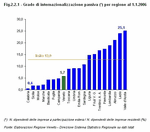 |
| Table 2.2.3 |
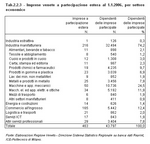 |
| Figure 2.2.2 |
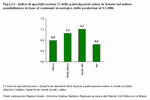 |
| Figure 2.2.3 |
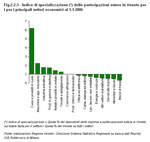 |
| Table 2.2.4 |
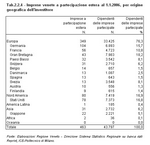 |
| Table 2.2.5 |
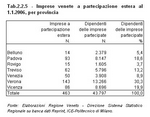 |
| Table 2.2.6 |
 |
| Figure 2.2.4 |
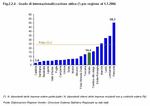 |
| Table 2.2.7 |
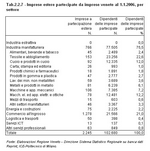 |
| Figure 2.2.5 |
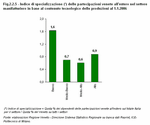 |
| Figure 2.2.6 |
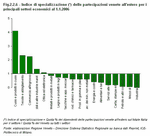 |
| Table 2.2.8 |
 |
| Table 2.2.9 |
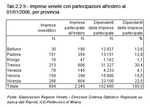 |
| Chapter 2 in figures |
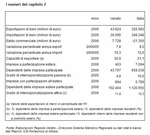 |
|


 Index
Index  Back
Back














